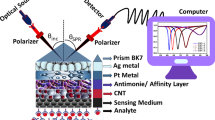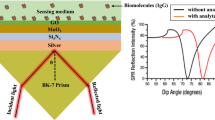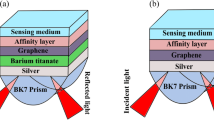Abstract
Mycobacterium tuberculosis bacteria is an illness that affects many people worldwide. Early diagnosis is crucial for patient care and can lower the death rate. As a result, sensitive and rapid detection of mycobacterium tuberculosis bacteria in the blood is crucial. In this paper, a novel surface plasmon resonance (SPRE) sensor consisting of a coupling prism, silver (Ag), barium titanate (BaTiO3) and graphene (Gr) layers is presented. The transfer matrix (TM) technique is used for the analysis of the SPRE structure. The Ag and BaTiO3 thicknesses and the number of Gr sheets are optimized to get the highest sensitivity of the proposed SPRE biosensor. The full width at half maximum (FWHM), detection accuracy (DA) and figure of merit (FOM) are investigated. The best performance has been obtained with 65 nm (Ag), and 9 nm (BaTiO3). The number of Gr layers is investigated and optimized to two layers. The highest sensitivity of 300 deg./RIU has been obtained for the proposed SPRE biosensor when the optimized thicknesses are employed. Compared with existing SPRE biosensors in the literature, the proposed sensor exhibits greater sensitivity. The excellent performance makes this SPRE-based sensor promising to be used in numerous biosensing applications.









Similar content being viewed by others
Availability of Data and Material
Detail about data has been provided in the article.
Code Availability
The used code can be obtained from the corresponding author upon request.
References
World Health Organization (2022) Global Tuberculosis Report 2022. WHO, Geneva, Switzerland
Houben RMGJ, Dodd PJ (2016) The Global Burden of Latent Tuberculosis Infection: A Re-estimation Using Mathematical Modelling. PLoS Med 13:e1002152
Hrizi O, Gasmi K, Ben Ltaifa I, Alshammari H, Karamti H, Krichen M, Ben Ammar L, Mahmood MA (2022) Tuberculosis Disease Diagnosis Based on an Optimized Machine Learning Model. J Healthc Eng 8950243
Sahu S, Wandwalo E, Arinaminpathy N (2022) Exploring the Impact of the COVID-19 Pandemic on Tuberculosis Care and Prevention. J Pediatric Infect Dis Soc 11:S67–S71
Wang CH, Chang JR, Hung SC, Dou HY, Lee GB (2022) Rapid molecular diagnosis of live Mycobacterium tuberculosis on an integrated microfluidic system. Sensor Actuat B-Chem 365:131968
Azadi D, Motallebirad T, Ghaffari K, Shojaei H (2018) Mycobacteriosis and Tuberculosis: Laboratory Diagnosis. Open Microbiol J 12:41–58
Soini H, Musser JM (2001) Molecular diagnosis of mycobacteria. Clin Chem 47:809–814
Vilcheze C, Kremer L (2017) Acid-Fast Positive and Acid-Fast Negative Mycobacterium tuberculosis: The Koch Paradox. Microbiol Spectr 5:1–14
Pande T, Cohen C, Pai M, Khan FA (2016) Computer-aided detection of pulmonary tuberculosis on digital chest radiographs: A systematic review. Int J Tuberc Lung D 20:1226–1230
Mustafa F, Andreescu S (2018) Chemical and biological sensors for food-quality monitoring and smart packaging. J Food Sci Technol 49(4):383–406
Bhatia S, Jiang YC, Sun MJ, **ong RJ (2018) Development of a surface plasmon resonance acetone sensor for noninvasive screening and monitoring of diabetes. Mater Sci Eng 383:012024
Srivastava A, Prajapati YK (2019) Performance Analysis of Silicon and Blue Phosphorene / MoS 2 Hetero-Structure Based SPRE Sensor. Photonic Sens 9(3):284–292
De Melo AA, Brito T, Fernanda M, Moreira S, Moreno R, Cruz S (2018) Theoretical analysis of sensitivity enhancement by graphene usage in optical Fiber surface plasmon resonance sensors. IEEE Trans Instrum Meas 68(5):1554–1560
Pal A, Jha A (2021) A theoretical analysis on sensitivity improvement of an SPRE refractive index sensor with graphene and barium titanate nanosheets. Optik - International Journal for Light and Electron Optics 231:166378
Bhardwaj S, Pathak NK, Ji A et al (2017) Tunable Properties of Surface Plasmon Resonance of Metal Nanospheroid: Graphene Plasmon Interaction. Plasmonics 12:193–201. https://doi.org/10.1007/s11468-016-0249-7
Arsalani S, Ghodselahi T, Neishaboorynejad T et al (2019) DNA Detection Based on Localized Surface Plasmon Resonance Spectroscopy of Ag@Au Biocomposite Nanoparticles. Plasmonics 14:1419–1426. https://doi.org/10.1007/s11468-019-00937-6
Alaguvibisha G et al (2020) Sensitivity enhancement of surface plasmon resonance sensor using hybrid configuration of 2D materials over bimetallic layer of Cu-Ni. Opt Commun 463:125337
Vahedi A, Kouhi M (2020) Liquid crystal-based surface plasmon BiosensorResonance. Plasmonics 15:61–71
Song B, Li D, Qi W, Elstner M, Fan C, Fang H (2010) Graphene on Au (111): A Highly Conductive Material with Excellent Adsorption Properties for High-Resolution Bio / Nanodetection and Identification. ChemPhysChem 19(111):585–589
Papageorgiou DG, Kinloch IA, Young RJ (2017) Progress in Materials Science Mechanical properties of graphene and graphene-based nanocomposites. Prog Mater Sci 90:75–127
Reina G, Gonz´ alez-Domínguez JM, Criado A, V´ azquez E, Bianco A, Prato M (2017) Promises, facts and challenges for graphene in biomedical applications. Chem Soc Rev 46(15):4400–4416
Aksimsek S, Jussila H, Sun Z (2018) Graphene – MoS 2 – metal hybrid structures for plasmonic biosensors. Opt Commun 428:233–236
Dai X, Liang Y, Zhao Y, Gan S, Jia Y, **ang Y (2019) Sensitivity enhancement of a surface plasmon resonance with tin selenide (SnSe) allotropes. Sensors 19(1):173
Gan S, Zhao Y, Dai X, **ang Y (2019) Sensitivity enhancement of surface plasmon resonance sensors with 2D franckeite nanosheets. Results Phys 13:102320
Nisha A, Maheswari P, Anbarasan PM, Rajesh KB, Jaroszewicz Z (2019) Sensitivity enhancement of surface plasmon resonance sensor with 2D material covered noble and magnetic material (Ni). Opt Quantum Electron 51(1)
Singh Y, Raghuwanshi SK (2019) Electromagnetic wave sensors sensitivity enhancement of the surface plasmon resonance gas sensor with black phosphorus. IEEE Sensors Lett 3(12):1–4
Pal S, Verma A, Saini JP, Prajapati YK (2019) Sensitivity enhancement using silicon-black phosphorus-TDMC coated surface plasmon resonance biosensor. IET Optoelectron 13(4):196–201
Singh Y, Paswan MK, Raghuwanshi SK (2020) Sensitivity enhancement of SPRE sensor with the black phosphorus and graphene with Bi-layer of gold for chemical sensing. Plasmonics
Ball JP, Mound BA, Nino JC, Allen JB (2014) Biocompatible evaluation of barium titanate foamed ceramic structures for orthopedic applications. J Biomed Mater Res - Part A 102(7):2089–2095
Marino A et al (2019) Piezoelectric barium titanate nanostimulators for the treatment of glioblastoma multiforme. J Colloid Interface Sci 538:449–461
Mudgal N, Saharia A, Choure KK et al (2020) Sensitivity enhancement with anti-reflection coating of silicon nitride (Si3N4) layer in silver-based Surface Plasmon Resonance (SPR) sensor for sensing of DNA hybridization. Appl Phys A 126:946. https://doi.org/10.1007/s00339-020-04126-9
Mudgal N, Yupapin P, Ali J et al (2020) BaTiO3-Graphene-Affinity Layer-Based Surface Plasmon Resonance (SPR) Biosensor for Pseudomonas Bacterial Detection. Plasmonics 15:1221–1229. https://doi.org/10.1007/s11468-020-01146-2
Wang S, Zhang J, Liu N et al (2023) Sensitivity Improvement of Bimetallic Layer-Based SPR Biosensor Using ZnO and Black Phosphorus. Plasmonics. https://doi.org/10.1007/s11468-023-01889-8
Lin Z, Jiang L, Wu L, Guo J, Dai X, **ang Y, Fan D (2016) Tuning and sensitivity enhancement of surface plasmon resonance biosensor with graphene covered Au MoS2-Au films. IEEE Photon J 8(6):1–8
Sun P, Wang M, Liu L, Jiao L, Wei Du, **a F, Liu M, Kong W, Dong L, Yun M (2019) Sensitivity enhancement of surface plasmon resonance biosensor based on graphene and barium titanate layers. Appl Surf Sci 475:342–347
Bruna M, Borini S (2009) Optical constants of graphene layers in the visible range. Appl Phys Lett 94(3):03190
Reddy NM, Kothandan D, Lingam SC, Ahmad A (2012) A study on refractive index of plasma of blood of patients suffering from tuberculosis. Int J Technol Eng 8:23–25
Lin C, Chen S (2019) Design of high-performance Au-Ag-dielectric-graphene based surface plasmon resonance biosensors using genetic algorithm. J Appl Phys 125:113101
Lin C, Chen S (2019) Sensitivity comparison of graphene based nearly guided-wave surface plasmon resonance biosensors with Au, Ag, Cu, and Al. J Nanophotonics 13:016006
Maharana PK, Jha R (2012) Chalcogenide prism and graphene multilayer based surface plasmon resonance affinity biosensor for high performance. Sens Actuat B Chem 169:161–166
Hossain MB, Mehedi IM, Moznuzzaman M, Abdulrazak LF, Hossain MA (2019) High performance refractive index SPRE sensor modeling employing graphene tri sheets, Vol. 15, Results in Physics, p. 102719
Pal S, Prajapati YK, Saini JP (2020) Influence of grapheme’chemical potential on SPRE biosensor using ZnO for DNA hybridization, Vol. 27, Optical Review, pp. 57–64
Singh S, Sharma AK, Lohia P, Dwivedi DK (2021) Theoritical analysis of sensitivity enhancement of surface plasmon resonance biosensor with zinc oxide and blue phosphorus/MoS2 heterostructure, Vol. 244, Optik, p. 167618
Almawgani AHM, Daher MG, Taya SA, Olaimat MM, Alhawari ARH, Colak I (2022) Detection of blood plasma concentration theoretically using SPR-based biosensor employing black phosphor layers and different metals. Plasmonics 17(4):1751–1764
Taya SA, Al-Ashi NE, Ramahi OM, Colak I, Amiri IS (2021) Surface plasmon resonance-based optical sensor using a thin layer of plasma. J Opt Soc Am B 38(8):2362–2367. https://doi.org/10.1364/JOSAB.420129
Hsu SH, Lin YY, Lu SH, Tsai IF, Lu YT, Ho HT (2013) Mycobacterium tuberculosis DNA detection using surface plasmon resonance modulated by telecommunication wavelength. Sensors (Basel) 14(1):458–467. https://doi.org/10.3390/s140100458. PMID: 24379050; PMCID: PMC3926568
Kaur B, Kumar S, Kaushik BK (2022) Antimonene, CNT and MoS2 Based SPR-Fiber-Optic Probe for Tuberculosis Detection. IEEE Sens J 22(15):14903–14910. https://doi.org/10.1109/JSEN.2022.3186995
Acknowledgements
The authors are thankful to the Deanship of Scientific Research at Najran University for funding this work under the Research Groups Funding program grant code (NU/RG/SERC/12/4).
Funding
Deanship of Scientific Research at Najran University.
Author information
Authors and Affiliations
Contributions
The authors confirm their contribution to the paper as follows: study conception and design (Sofyan A. Taya and Malek G. Daher). Software (Abdulkarem H. M. Almawgani). Interpretation of results (Malek G. Daher and Ilhami Colak). Draft manuscript preparation (Ayman Taher Hindi and Malek G. Daher). Writing the final version (Shobhit K. Patel and Sofyan). Supervision (Sofyan A. Taya). All authors reviewed the results and approved the final version of the manuscript.
Corresponding author
Ethics declarations
Ethics Approval
This study does not require ethics approval.
Consent to Participate
No consent to participate is required for this study.
Consent for Publication
No consent for publication is required for this study.
Conflicts of Interest
The authors declare no conflict of interest.
Additional information
Publisher's Note
Springer Nature remains neutral with regard to jurisdictional claims in published maps and institutional affiliations.
Rights and permissions
Springer Nature or its licensor (e.g. a society or other partner) holds exclusive rights to this article under a publishing agreement with the author(s) or other rightsholder(s); author self-archiving of the accepted manuscript version of this article is solely governed by the terms of such publishing agreement and applicable law.
About this article
Cite this article
Daher, M.G., Taya, S.A., Almawgani, A.H.M. et al. Optical Biosensor Based on Surface Plasmon Resonance Nanostructure for the Detection of Mycobacterium Tuberculosis Bacteria with Ultra-High Efficiency and Detection Accuracy. Plasmonics 18, 2195–2204 (2023). https://doi.org/10.1007/s11468-023-01938-2
Received:
Accepted:
Published:
Issue Date:
DOI: https://doi.org/10.1007/s11468-023-01938-2




